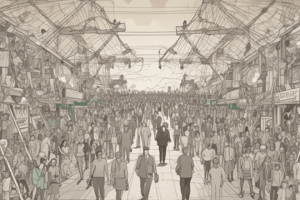Podcast
Questions and Answers
What is the primary focus of functionalism in social theory?
What is the primary focus of functionalism in social theory?
- The influence of technology on society
- The stability and interdependence of societal parts (correct)
- The role of cultural norms in individual behavior
- The conflicts between social classes
Which type of social group is characterized by a close-knit and intimate relationship?
Which type of social group is characterized by a close-knit and intimate relationship?
- Primary group (correct)
- Informal network
- Secondary group
- Formal organization
What role do family, schools, peers, and media play in society?
What role do family, schools, peers, and media play in society?
- They are primarily sources of conflict
- They contribute to economic shifts
- They are agents of socialization (correct)
- They serve as formal institutions only
Which aspect does not typically influence social class?
Which aspect does not typically influence social class?
What is considered a form of social interaction?
What is considered a form of social interaction?
Which of the following is a common driver of social change?
Which of the following is a common driver of social change?
What is the significance of social connections in society?
What is the significance of social connections in society?
Which of the following is considered a social issue?
Which of the following is considered a social issue?
Flashcards are hidden until you start studying
Study Notes
Definition of Social
- Pertaining to society or its organization.
- Involves interactions among individuals and groups.
Types of Social Structures
-
Groups: Collections of individuals who interact and share a sense of unity.
- Primary Groups: Close-knit, intimate (e.g., family, close friends).
- Secondary Groups: Larger, more formal (e.g., coworkers, classmates).
-
Institutions: Established structures in society that meet basic social needs.
- Examples: Family, education, economy, government, religion.
-
Networks: Webs of social relationships that connect individuals.
- Can be formal (organizations) or informal (friendships).
Social Interaction
- The process by which people act and react in relation to others.
- Forms include cooperation, competition, conflict, and accommodation.
Socialization
- The lifelong process through which individuals learn and internalize the values, beliefs, and norms of their culture.
- Agents of socialization include:
- Family
- Schools
- Peers
- Media
Social Groups and Class
- Social Class: A division of society based on social and economic status.
- Influences access to resources, opportunities, and lifestyle.
Social Change
- Refers to significant alterations over time in behavior patterns, cultural values, and norms.
- Can be driven by:
- Technology
- Social movements
- Economic shifts
- Political changes
Importance of Social Connections
- Provide emotional support and well-being.
- Facilitate access to information and resources.
- Enhance opportunities for collaboration and cooperation.
Social Issues
- Common topics of study include:
- Inequality
- Poverty
- Discrimination
- Crime
- Health disparities
Theories of Social Behavior
- Functionalism: Views society as a complex system whose parts work together to promote stability.
- Conflict Theory: Focuses on the struggles between social classes and the inequalities they produce.
- Symbolic Interactionism: Examines daily interactions and the meanings individuals attach to them.
Impact of Technology on Social Dynamics
- Social media reshapes communication and relationships.
- Increases globalization and cultural exchange.
- Raises issues related to privacy and mental health.
Definition of Social
- Refers to matters related to society and its organization.
- Involves interpersonal and group interactions.
Types of Social Structures
- Groups: Composed of individuals with a shared identity.
- Primary Groups: Smaller, intimate relationships (e.g., family, close friends).
- Secondary Groups: Larger, more formalized relationships (e.g., coworkers, classmates).
- Institutions: Essential structures fulfilling societal needs.
- Examples include family, education systems, economic entities, governments, and religious organizations.
- Networks: Interconnected social relationships.
- Can be formal (e.g., business organizations) or informal (e.g., friendships).
Social Interaction
- Encompasses actions and reactions among individuals.
- Forms include cooperation, competition, conflict, and accommodation.
Socialization
- A lifelong journey of learning cultural values, beliefs, and norms.
- Major socialization agents include family, educational institutions, peers, and media.
Social Groups and Class
- Social Class: Categorization based on economic and social status.
- Impacts access to resources, opportunities, and overall lifestyle.
Social Change
- Refers to significant shifts in cultural values, behaviors, and norms over time.
- Influenced by various factors including:
- Technological advancements.
- Social movements advocating for change.
- Economic fluctuations.
- Political developments.
Importance of Social Connections
- Provide essential emotional support and enhance well-being.
- Offer access to valuable information and resources.
- Foster opportunities for collaboration and teamwork.
Social Issues
- Key topics of concern include:
- Social inequality and its implications.
- Poverty and its effects on communities.
- Discrimination in various societal realms.
- Crime rates and their societal impact.
- Disparities in health and healthcare access.
Theories of Social Behavior
- Functionalism: Analyzes society as a cohesive system where parts work synergistically for stability.
- Conflict Theory: Investigates the power struggles between social classes and the resulting inequalities.
- Symbolic Interactionism: Focuses on daily interactions and the meanings individuals assign to them.
Impact of Technology on Social Dynamics
- Social media transforms modes of communication and interpersonal relationships.
- Promotes globalization and cultural exchanges across borders.
- Sparks concerns regarding privacy and mental health implications.
Studying That Suits You
Use AI to generate personalized quizzes and flashcards to suit your learning preferences.



